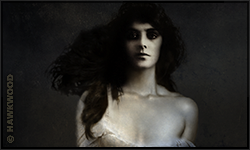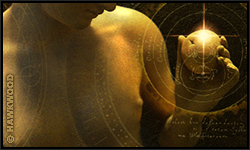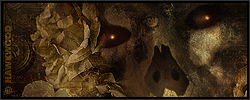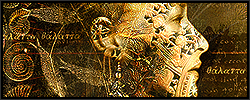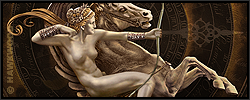With rope and wax and misplaced trust
you mute our songs to choke your fear
and think to buy our silence here
with artful schemes and stifled lust;
how quaintly defiant of you
to stop your ears with wax -
so ply your oars and bend your backs
as all the while
the cruel wind roars and the darkness cracks
around you, our silence bought with your guile,
and hempen ropes to bind you fast;
trussed like fools to your oars and mast.
As if that would arm you against us!
Such false security lulls.
For the bees that laboured to make the wax
also created the golden honey
that our singing pours into your skulls.
Those same bees are our allies
and scheme against your fires.
See: you need only to gaze upon us,
and your brains boil with your desires.
White-hot, the wax melts, and you are helpless:
you hear our songs, and from that moment you are ours.
Did you really seriously imagine
that you always would have things your way?
It has been millennia; thousands of years
of being denied our true selves through your fears.
Thousands of years of our bodies’ violation,
of keeping us safely confined to our station
and doing for you what is meet
with rules made by men in the name of their god
then claiming such writings as his holy word,
and even of being afraid of our hair
as under your rules we all have to wear
hats in church, hijabs on the street:
a denied womanhood in your vanity fair.
So just go ahead:
you can stop your ears with wax
and listen to nothing instead,
you can bind yourselves to the mast.
But the bees work with us in dark alliance
and are on our side,
so now you must see us at last:
our hair is a long, flowing flag of defiance,
the banner of a justice long denied.
And now you taste at last
the same fear we have tasted
these centuries past.
Centuries of fear in lifetimes wasted:
of not being free to walk the streets at night,
our movements confined by a curfew nightfall
because your desires seized a stolen requite:
desires which were not true desires at all.
So you can stop your ears with wax
but you cannot quench the fire.
For remember the bees work against you
as does your desire.
White-hot and melting together
The centuries hear our songs
and the moon will finally take her rest
where the moon belongs.
And we who have borne these many wrongs
feel in the rush of time
the raging wind of our wings
and the unfolding sublime.
And whether you choose to or not
you will listen to our songs
and the moon will find her rest at last
where the moon belongs.
©David Bergen Studio
(In Homer’s epic ‘The Odyssey’, to sail his ship safely past the sirens’ island and avoid their fatal singing that would lure both himself and his crew to their watery deaths, Odysseus has his men stop their ears with wax. Curious to hear their songs he has himself bound to the mast with instructions that, however much he pleads to be freed, he was not be released until they were safely past the hazard.)


